Effects of Traditional Ethnic Minority Food Culture on Genetic Diversity in Rice Landraces in Guizhou Province, China
Abstract
1. Introduction
2. Materials and Methods
2.1. Plant Materials
2.2. DNA Extraction and SSR Molecular Marker Assays
2.3. Population Structure and Differentiation and Haplotype Analysis
3. Results
3.1. Statistical Analysis of Total Genetic Diversity
3.2. Population Genetic Analysis with SSR Markers
3.3. Genetic Variation in Rice Landraces before and after Short-Term Domestication by Ethnic Minorities
3.4. Network Relationships of Haplotypes Based on Target Genes
4. Discussion
4.1. Evaluation of Genetic Diversity in Rice Landraces
4.2. Synergistic Evolution of Rice Landraces and Traditional Dietary Cultures
4.3. Effective Conservation Mechanisms of Genetic Diversity in Rice Landraces
5. Conclusions
Supplementary Materials
Author Contributions
Funding
Data Availability Statement
Conflicts of Interest
References
- Ruan, R.C.; Chen, H.C.; Chen, N.G.; You, J.M.; Chen, F.; Jiao, A.X.; Tan, J.Y.; Tu, M.; Li, X.B. Progress on the research and utilization of rice germplasm resources in Guizhou in the 21st century. J. Mt. Agric. Biol. 2015, 34, 1–8. [Google Scholar]
- Zheng, D.S.; Gao, A.N.; Li, L.H.; Liu, X. Rare germplasm resources of crop and wild relatives of minority area in Guizhou province. J. Plant Genet. Resour. 2016, 17, 570–576. [Google Scholar]
- Liu, C.H.; Cui, D.; Jiao, A.X.; Ma, X.D.; Li, X.B.; Han, B.; Chen, H.C.; Ruan, R.C.; Wang, Y.J.; Han, L.Z. Kam sweet rice (Oryza sativa L.) is a special ecotypic rice in southeast Guizhou, China as revealed by genetic diversity analysis. Front. Plant Sci. 2022, 13, 830556. [Google Scholar] [CrossRef] [PubMed]
- Pusadee, T.; Jamjod, S.; Chiang, Y.C.; Rerkasem, B.; Schaal, B.A. Genetic structure and isolation by distance in a landrace of Thai rice. Proc. Natl. Acad. Sci. USA 2009, 106, 13880–13885. [Google Scholar] [CrossRef]
- Lachagari, V.; Gupta, R.; Lekkala, S.; Mahadevan, L.; Kuriakose, B.; Chakravartty, N.; Thomas, G. Whole Genome Sequencing and Comparative Genomic Analysis Reveal Allelic Variations Unique to a urple Colored Rice Landrace (Oryza sativa ssp. indica cv. Purpleputtu). Front. Plant Sci. 2019, 10, 513. [Google Scholar] [CrossRef] [PubMed]
- Liu, C.H.; Yang, J.B.; Yin, L. Progress, achievements and prospects of biodiversity rotection in Yunnan Province. Biodivers. Sci. 2021, 29, 200–211. [Google Scholar] [CrossRef]
- Cui, D.; Li, J.M.; Tang, C.F.; Ma, X.X.; Yu, T.Q.; Ma, X.D.; Zhan, E.L.; Cao, G.L.; Xu, F.R.; Qiao, Y.L.; et al. Diachronic analysis of genetic diversity in rice landraces under on-farm conservation in Yunnan, China. Theor. Appl. Genet. 2016, 129, 155–168. [Google Scholar] [CrossRef]
- Qi, Y.W.; Zhang, D.L.; Zhang, H.L.; Wang, M.X.; Sun, J.L.; Liao, D.Q.; Wei, X.H.; Qiu, Z.E.; Tang, S.X.; Cao, Y.S.; et al. Genetic diversity of selected rice varieties in China and its trends in recent 50 years. Chin. Sci. Bull. 2006, 51, 693–699. [Google Scholar] [CrossRef]
- Chen, W.Z.; Fan, J.F.; Zhou, Y.X.; Gao, J.S.; Yu, Y.Y.; Wang, Y.X. Genetic diversity analysis of the 10 poplar accessions based on SSR molecular markers. J. Northwest For. Univ. 2021, 36, 88–93. [Google Scholar]
- Negri, V. Agro-Biodiversity Conservation in Europe: Ethical Issues. J. Agric. Environ. Ethn. 2005, 18, 3–25. [Google Scholar] [CrossRef]
- Bertuso, A.; Ginogaling, G.; Salazar, R. Community gene banks: The experience of conserve in the Philippines. In Encouraging Diversity: The Conservation and Development of Plant Genetic Resources; Almekinders, C.J.M., de Boef, W.S., Eds.; Intermediate Technology Publications: London, UK, 2000; pp. 117–122. [Google Scholar]
- Fuller, D.Q.; Rowlands, M. Ingestion and food technologies: Maintaining differences over the long-term in West, South and East Asia. In Interweaving Worlds-Systematic Interactions in Eurasia, 7th to 1st Millennia BC; Wilkinson, T., Ed.; Essays from a Conference in Memory of Professor Andrew Sherratt; Oxbow Books: Oxford, UK, 2011; pp. 37–60. [Google Scholar]
- Xu, F.R.; Yang, Z.Y.; Zhang, E.L.; Ma, X.X.; Tang, C.F.; Dong, C.; Zhang, F.F.; Liu, X.; Dai, L.Y. On-farm conservation and utilization of paddy rice, wheat and maize landrace varieties in 15 unique ethnic groups in Yunnan, China. Hereditas 2012, 34, 1465–1474. [Google Scholar] [CrossRef] [PubMed]
- Dong, C.; Xu, F.R.; Yang, W.Y.; Tang, C.F.; Zhang, E.L.; Yang, Y.Y.; Ma, X.X.; Zhang, F.F.; Lu, G.D.; Wang, Y.; et al. Genetic variation analysis of paddy rice landrace of Yuelianggu from Yuanyang Hani’s terraced fields in Yunnan province. Chin. J. Rice Sci. 2013, 27, 137–144. [Google Scholar]
- Dong, C.; Ma, X.X.; Tang, F.; Zheng, F.F.; Yang, Y.Y.; Shen, S.Q.; Dai, L.Y. Phenotypic diversity analysis and excellent resource screening of rice landraces planting in Hani ethnic group region in Yunnan. J. South Agric. 2022, 51, 1013–1021. [Google Scholar]
- Khan, A.; Goldringer, I.; Thomas, M. Management practices and breeding history of varieties strongly determine the fine genetic structure of crop populations: A case study based on European wheat populations. Sustainability 2020, 12, 613. [Google Scholar] [CrossRef]
- Zhu, M.; Ruan, R.C.; Nie, L. Status and prospects for conservation of crop germplasm resources in Guizhou. Guizhou Agric. Sci. 2007, 35, 163–166. [Google Scholar]
- Ruan, R.C.; Chen, H.C.; You, J.M.; Zhu, Y.Q.; Zhu, M.; Chen, N.G. Current Status and Prospects of Conservation for Rice Genetic Resources in Guizhou. Seeds 2007, 26, 53–56. [Google Scholar]
- Wang, Y.J.; Jiao, A.X.; Chen, H.C.; Ma, X.D.; Cui, D.; Han, B.; Xue, D.Y.; Han, L.Z. Status and factors influencing on-farm conservation of Kam Sweet Rice (Oryza sativa L.) genetic resources in southeast Guizhou Province, China. J. Ethnobiol. Ethnomed. 2018, 14, 76. [Google Scholar] [CrossRef]
- Yang, C.; Liu, K.; Tan, H.Y.; Yu, X.Q.; Zhou, L.J. Genetic diversity analysis of local red rice varieties in Guizhou. Seed 2021, 3, 15–22. [Google Scholar]
- Chen, N.G.; Chen, H.C.; You, J.M.; Ruan, R.C. Path analysis of main agronomic characters and clustering of upland rice in Guizhou. Guizhou Agric. Sci. 2010, 38, 46–49. [Google Scholar]
- Liu, C.H.; Wang, Y.J.; Ma, X.D.; Cui, D.; Han, B.; Xue, D.Y.; Han, L.Z. Traditional Agricultural Management of Kam Sweet Rice (Oryza Sativa L.) in Southeast Guizhou Province, China. J. Ethnobiol. Ethnomed. 2022, 18, 30. [Google Scholar] [CrossRef]
- Yang, Z.H. Civilization and mutual learning: The study on glutinous rice cultural circle and its Changes. J. Minzu Univ. China 2021, 48, 60–72. [Google Scholar]
- Huang, G.Q. Planting, food making and sacrifice giving whit glutinous rice among ethnic groups of the Zhuang-Dong linguistic family in China. Ethn. Stud. Guangxi 2016, 1, 80–87. [Google Scholar]
- Lei, Q.Y.; Zhou, J.J.; Xiong, Y.; Zhang, W.H.; Luo, J.; Long, C.L. Genetic Diversity Evaluation and Conservation of Kam Fragrant Glutinous Rice (Oryza sativa L.) Germplasm in Southeast Guizhou, China. Plants 2021, 10, 1898. [Google Scholar] [CrossRef] [PubMed]
- Doyle, J.J.; Dickson, E.E. Preservation of plant samples for DNA restriction endonuclease analysis. Taxon 1987, 36, 715–722. [Google Scholar] [CrossRef]
- Wang, Y.J.; Wang, Y.L.; Sun, X.D.; Caiji, Z.M.; Yang, J.B.; Cui, D.; Cao, G.L.; Ma, X.D.; Han, B.; Xue, D.Y.; et al. Influence of ethnic traditional cultures on genetic diversity of rice landraces under on-farm conservation in southwest China. J. Ethnobiol. Ethnomed. 2016, 12, 51. [Google Scholar] [CrossRef]
- Liu, K.; Muse, S.V. PowerMarker: An integrated analysis environment for genetic marker analysis. Bioinformatics 2005, 21, 2128–2129. [Google Scholar] [CrossRef]
- Pritchard, J.K.; Stephens, M.; Donnelly, P. Inference of populations structure using multilocus genotype data. Genetics 2000, 155, 945–959. [Google Scholar] [CrossRef]
- Falush, D.; Stephens, M.; Pritchard, J.K. Inference of population structure using multilocus genotype data: Linked loci and correlated allele frequencies. Genetics 2003, 164, 1567–1587. [Google Scholar] [CrossRef]
- Wang, C.L.; Fan, Y.L.; Zheng, C.K.; Qin, T.F.; Zhang, X.P.; Zhao, K.J. High-resolution genetic mapping of rice bacterial blight resistance gene Xa23. Mol. Genet. Genom. 2014, 289, 745–753. [Google Scholar] [CrossRef]
- Chen, J.; Shi, Y.F.; Liu, W.Z.; Chai, R.Y.; Fu, Y.P.; Zhuang, J.Y.; Wu, J.L. A Pid3 allele from rice cultivar Gumei2 confers resistance to Magnaporthe oryzae. J. Genet. Genom. 2011, 38, 209–216. [Google Scholar] [CrossRef]
- Thompson, J.D.; Gibson, T.J.; Plewniak, F.; Jeanmougin, F.; Higgins, D. The CLUSTALX windows interface: Flexible strategies for multiple sequence alignment aided by quality analysis tools. Nucleic Acids Res. 1997, 25, 4876–4882. [Google Scholar] [CrossRef] [PubMed]
- Rozas, J. DNA Sequence Polymorphism Analysis Using DnaSP. In Bioinformatics for DNA Sequence Analysis; Humana Press: Totowa, NJ, USA, 2009; Volume 537, pp. 337–350. [Google Scholar]
- Bandelt, H.J.; Forster, P.; Rohl, A. Median-joining networks for inferring intraspecific phylogenies. Mol. Biol. Evol. 1999, 16, 37–48. [Google Scholar] [CrossRef] [PubMed]
- Evanno, G.; Regnaut, S.; Goudet, J. Detecting the number of clusters of individuals using the software Structure: A simulation study. Mol. Ecol. 2005, 14, 2611–2620. [Google Scholar] [CrossRef] [PubMed]
- Li, J.; Zhang, X.F.; Huang, G.; Feng, Y.H. Research progress on local rice varietied of Kam Sweet Rice in Southeast of Guizhou. China Rice 2019, 25, 53–58. [Google Scholar]
- Lei, Q.Y.; Zhou, J.J.; Luo, J.; Zhang, W.H.; Sun, J.; Long, C.L. Changes in the numbers of Kam fragrant glutinous rice varieties in the Dong regions of Guizhou Province. Biodivers. Sci. 2017, 25, 990–998. [Google Scholar] [CrossRef][Green Version]
- Zhou, J.B.; Yang, T.; Lei, Q.Y.; Yan, H.G. Kam sweet rice in Miao and Dong folk culture in Qiandongnan prefecture. J. Xingyi Norm. Univ. Natly. 2020, 4, 4–8. [Google Scholar]
- Zhang, D.L.; Zhang, H.L.; Wei, X.H.; Qi, Y.W.; Wang, M.X.; Sun, J.L.; Ding, L.; Tang, S.X.; Qiu, Z.E.; Cao, Y.S.; et al. Genetic structure and diversity of Oryza sativa L. in Guizhou, China. Chin. Sci. Bull. 2007, 52, 343–351. [Google Scholar] [CrossRef]
- Yang, H.; Lu, C.M.; Jia, Y.F.; Han, G.Y.; Li, L.G.; Duan, L.; Wang, Y.Y. Genetic diversity of Yunnan glutinous rice revealed by SSR markers. Mol. Plant Breed. 2008, 6, 1068–1074. [Google Scholar]
- Chen, Y.; Chen, L.; Zhang, D.Y.; Xiao, S.Q.; Yin, F.Y.; Wang, L.X.; Wang, B.; Zhong, Q.F.; Fu, J.; Cheng, Z.Q. Genetic diversity and population structure analysis of rice germplasm resources in Yunnan province. Acta Agric. Boreali-Occident. Sin. 2019, 28, 1778–1789. [Google Scholar]
- Xu, F.R.; Dong, C.; Yang, W.Y.; Zhang, N.L.; Tang, C.F.; Ma, X.X. Genetic similarity analysis of main rice cultivars (lines) in Yunnan province based on phenotypic traits and SSR molecular markers. J. Plant Genet. Resour. 2011, 12, 700–708. [Google Scholar]
- Kumbhar, S.D.; Kulwal, P.L.; Patil, J.V.; Sarawate, C.D.; Gaikwad, A.P.; Jadhav, A. Genetic diversity and population structure in landraces and improved rice varieties from India. Rice Sci. 2015, 22, 99–107. [Google Scholar] [CrossRef]
- Muto, C.; Ebana, K.; Kawano, K.; Bounphanousay, V.; Fukuta, Y. Genetic variation in rice (Oryza sativa L.) germplasm from Northern Laos. Breed. Sci. 2019, 69, 272–278. [Google Scholar] [CrossRef] [PubMed]
- Song, Y.J.; Dong, Y.M.; Wang, J.; Feng, J.C.; Long, C.L. Tartary buckwheat (Fagopyrum tataricum Gaertn.) landraces cultivated by Yi people in Liangshan, China. Genet. Resour. Crop Evol. 2019, 67, 745–761. [Google Scholar] [CrossRef]
- Gao, A.N.; Zheng, D.S.; Li, L.H.; Liu, X. Utilization and conservation on crop germplasm resource of minority nationality in Guizhou province. J. Plant Genet. Resour. 2015, 16, 549–554. [Google Scholar]
- Chi, T.T.N.; Liem, P.V.; Paris, T. Farmers participation in rice variety selection. Omonrice 2007, 15, 159–163. [Google Scholar]
- Rana, R.B.; Garforth, C.; Sthapit, B.; Jarvis, D. Influence of socio-economic and cultural factors in rice varietal diversity management on-farm in Nepal. Agric. Hum. Values 2007, 24, 461–472. [Google Scholar] [CrossRef]
- Wei, Z.; Zhang, F.T.; Zhang, Y.; Li, Y.Z.; An, Y.Z.; Sun, C.C.; Yang, Q. Spatial and temporal distribution characteristics and influencing factors of ethnic minority villages in Guizhou. Guizhou Ethn. Stud. 2021, 239, 113–121. [Google Scholar]
- Yang, Z.H. Study on traditional rice farming and its ecological implication of minority nationalities in south China. Agric. Archaeol. 2016, 6, 58–66. [Google Scholar]
- Wang, W.S.; Mauleon, R.; Hu, Z.Q.; Chebotarov, D.; Tai, S.S.; Wu, Z.C.; Li, M.; Zheng, T.; Fuentes, R.R.; Zhang, F.; et al. Genomic variation in 3010 diverse accessions of Asian cultivated rice. Nature 2018, 557, 43–49. [Google Scholar] [CrossRef]
- Xian, J.L.; Zeng, X.F.; Zhao, D.G. Differentiation of Indica-Japonica rice varieties in Guizhou province based on InDel markers. Genom. Appl. Biol. 2013, 32, 486–496. [Google Scholar]
- Yang, W.B. From glutinous rice to nonluminous rice: A historic examination on crops’ planting and people’s habitat adaptability in the southeast of Guizhou province. Agric. Hist. China 2004, 4, 88–96. [Google Scholar]
- Cui, D.; Lu, H.F.; Tang, C.F.; Li, J.M.; Ma, X.X.; Yu, T.Q.; Ma, X.D.; Zhang, E.L.; Wang, Y.J.; Cao, G.L.; et al. Genomic analyses reveal selection footprints in rice landraces grown under on-farm conservation conditions during a short-term period of domestication. Evol. Appl. 2020, 13, 290–302. [Google Scholar] [CrossRef]
- Yin, G.K.; Xin, X.; Zhang, J.M.; Chen, X.L.; Liu, Y.X.; He, J.J.; Huang, X.Q.; Lu, X.X. The progress and prospects of theoretical research on the sage conservation of germplasm resources in genebank. Chin. Agric. Sci. 2022, 55, 1263–1270. [Google Scholar]
- Lu, X.X.; Xin, X.; Yin, G.K.; Zhang, J.M.; He, J.J. Crop germplasm resource bank, protection system and seed industry revitalization. China Seed Ind. 2021, 11, 1–5. [Google Scholar]
- Liu, X.; Li, L.H.; Li, Y.; Tan, G.W.; Zhou, M.L. Synergistic evolution theory of crop germplasm resources and cultural environments. J. Plant Genet. Resour. 2022, 23, 1–11. [Google Scholar]
- Xue, D.Y. Conservation and outlook of traditional knowledge associated with biodiversity. Biodivers. Sci. 2019, 27, 705–707. [Google Scholar]
- Schwartz, K.R.; Parsons, E.C.M.; Rockwood, L.; Wood, T.C. Integrating in-situ and ex-situ data management processes for biodiversity conservation. Front. Ecol. Evol. 2017, 5, 120. [Google Scholar] [CrossRef]

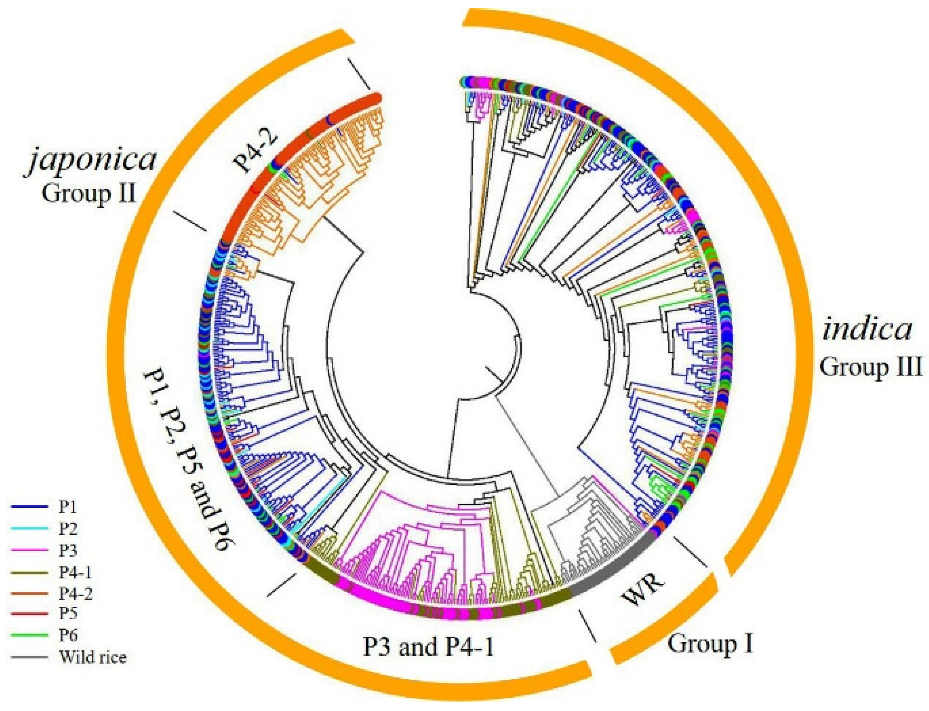
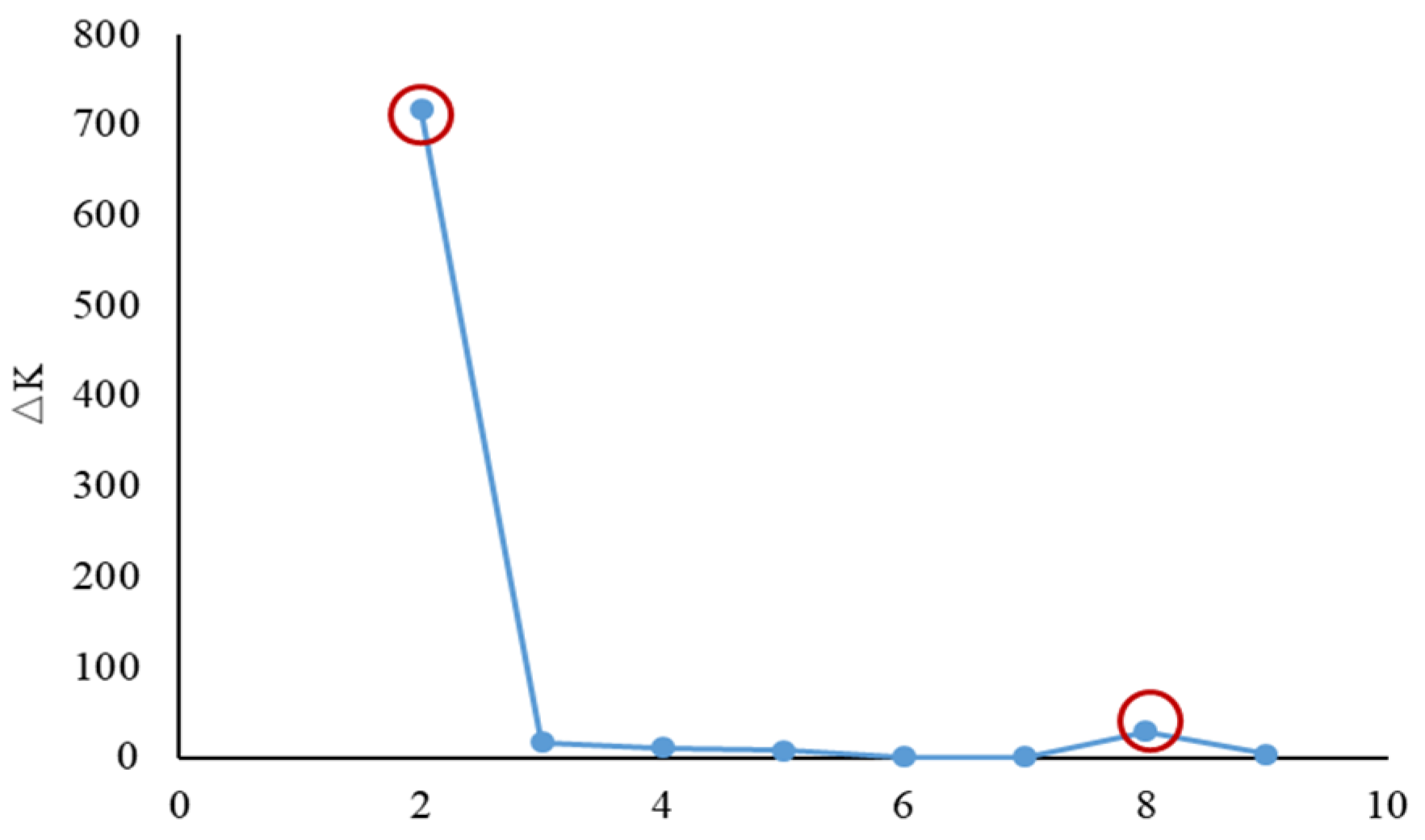
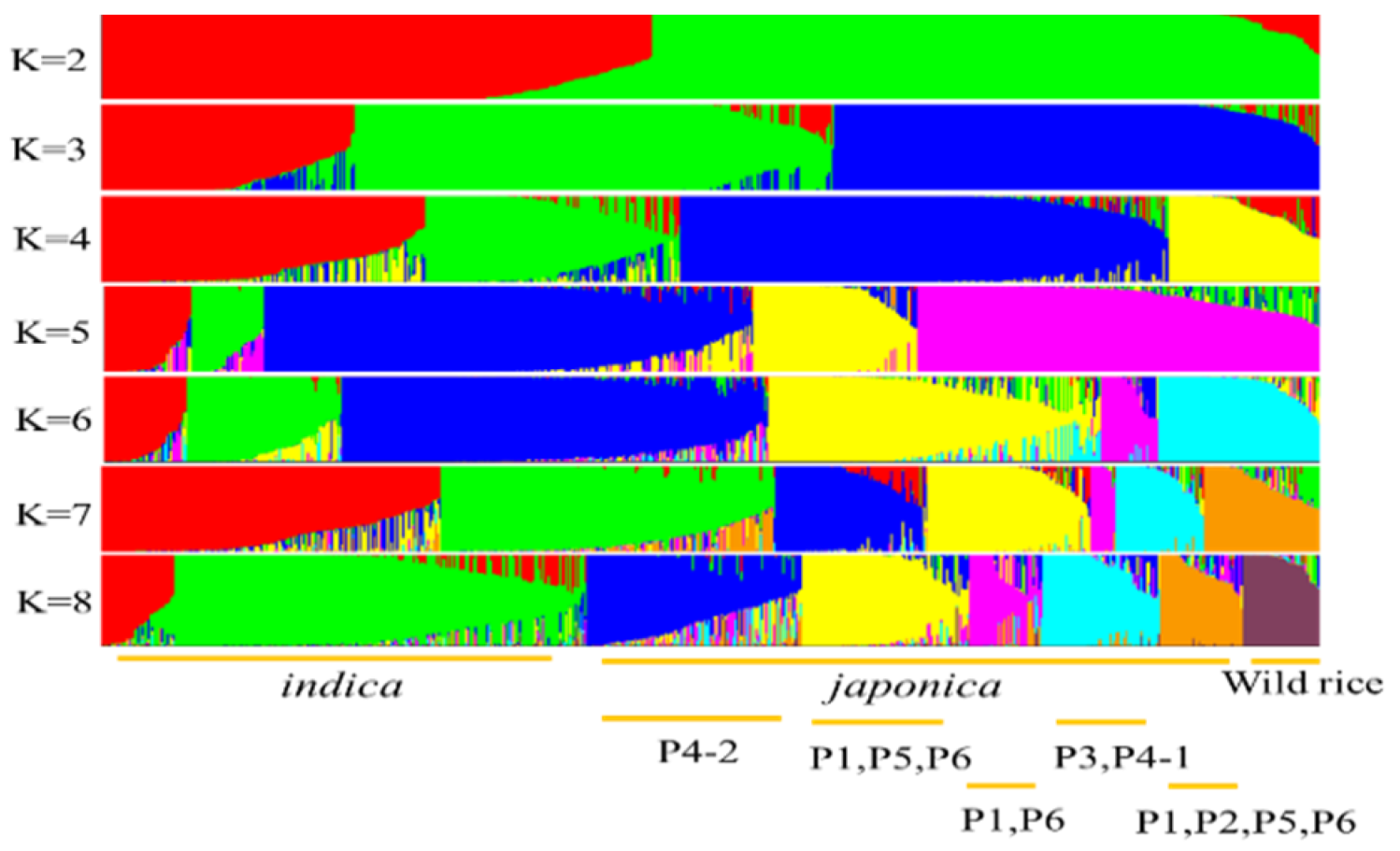
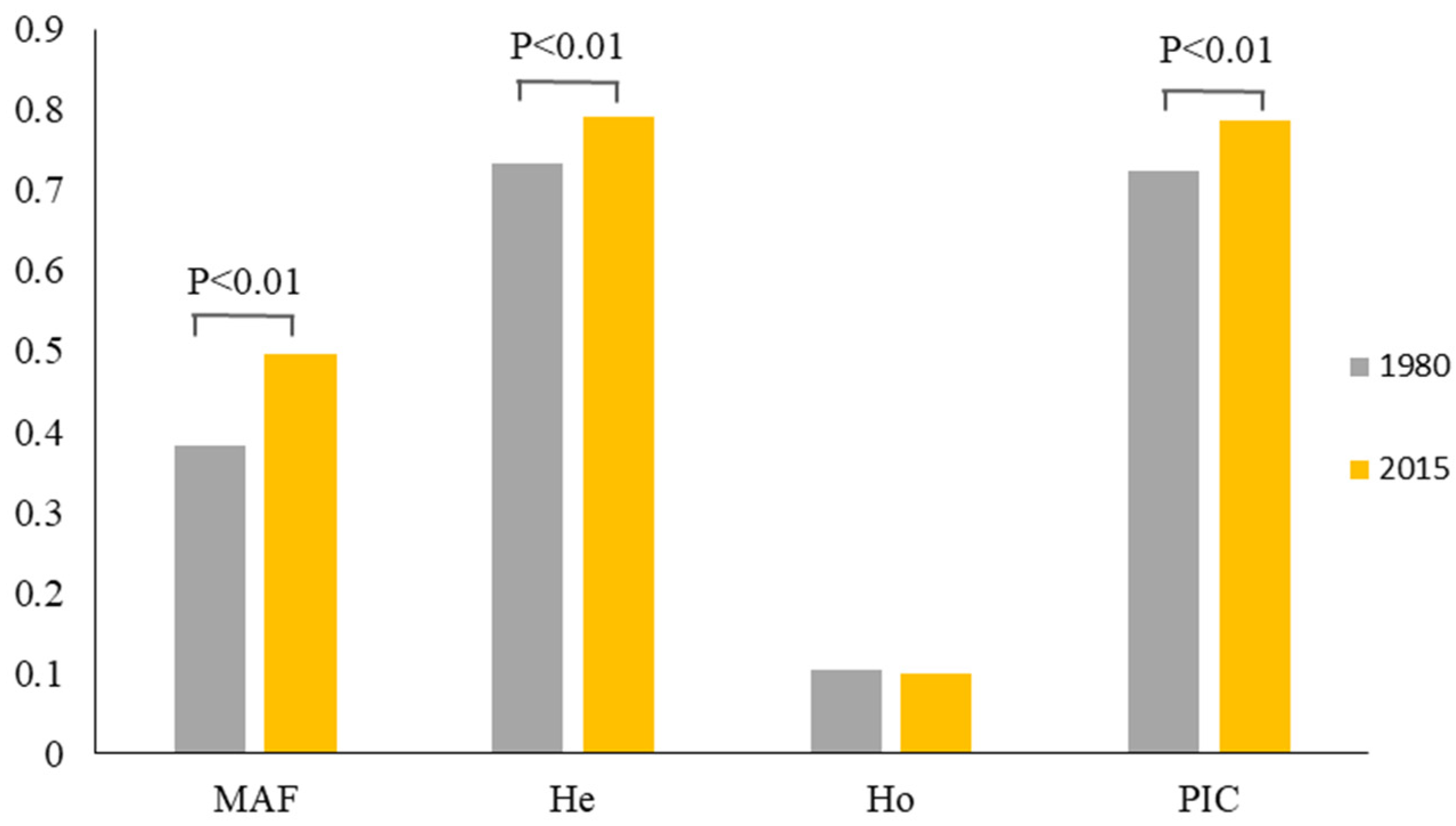
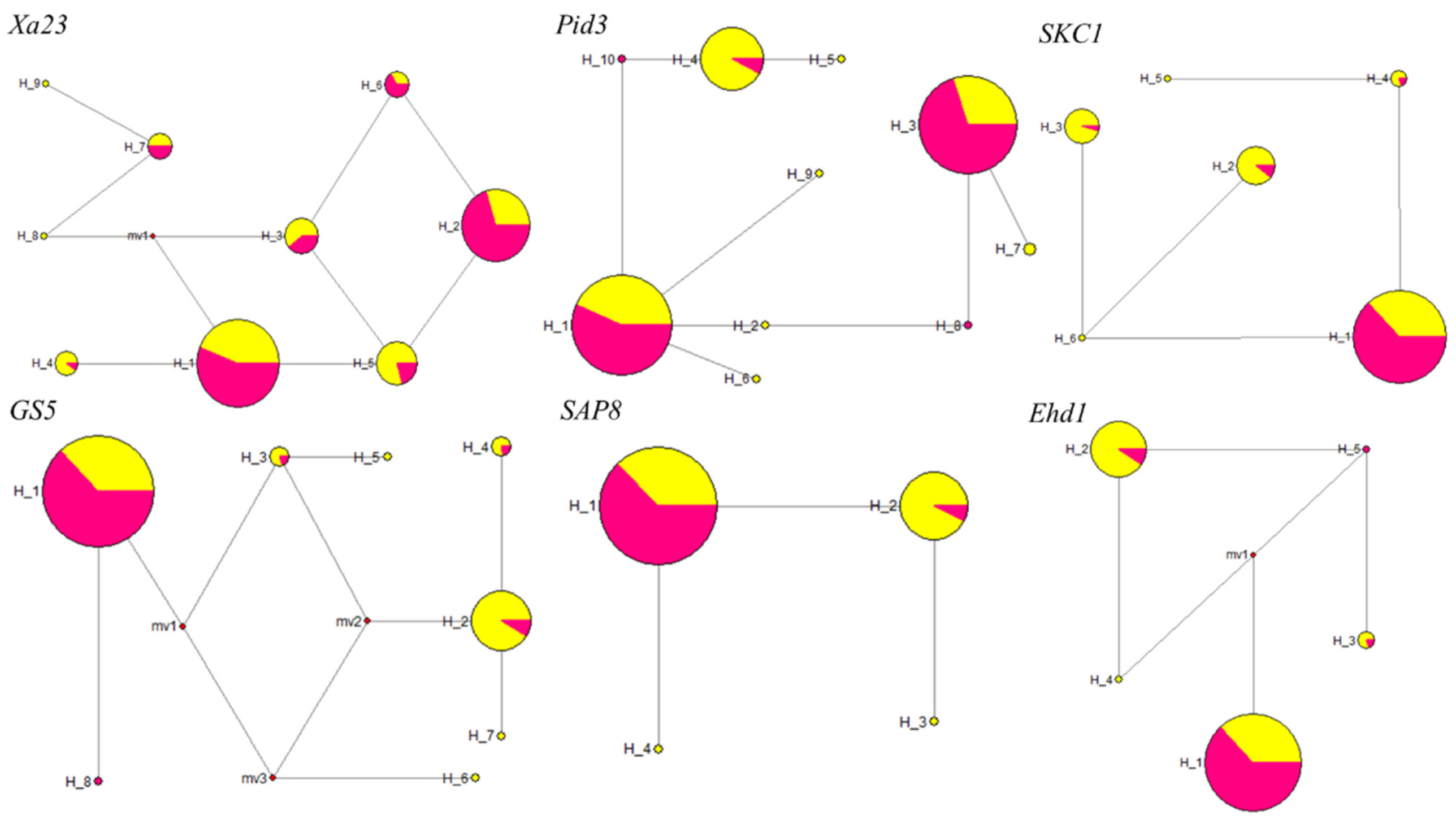

| Types of Accessions | Category | Population | Geographic Distribution | Number of Accessions | Release Time |
|---|---|---|---|---|---|
| The first set of accessions | Rice landraces | P1 | Central Guizhou | 190 | 1980 |
| P2 | Eastern Guizhou | 45 | 1980 | ||
| P3 | Southwestern Guizhou | 85 | 1980 | ||
| P4-1 | Southwestern and southern Guizhou | 84 | 1980 | ||
| P4-2 | Southeastern Guizhou | 142 | 1980 | ||
| P5 | Northern Guizhou | 23 | 1980 | ||
| P6 | Northwestern Guizhou | 29 | 1980 | ||
| Wild rice (WR) | P7 | Guangdong, Guangxi, and Hunan provinces | 42 | 1980 | |
| The second set of accessions | Rice landraces | / | Southeastern Guizhou | 164 | 2015 |
| Marker | Chr | Na | He | Ho | PIC | Marker | Chr | Na | He | Ho | PIC |
|---|---|---|---|---|---|---|---|---|---|---|---|
| RM44 | 8 | 19 | 0.8558 | 0.0734 | 0.8411 | RM228 | 10 | 42 | 0.8683 | 0.2375 | 0.8571 |
| RM287 | 11 | 13 | 0.8007 | 0.1219 | 0.7764 | RM21 | 11 | 22 | 0.6786 | 0.1516 | 0.6579 |
| RM336 | 7 | 21 | 0.8491 | 0.1641 | 0.8351 | RM449 | 1 | 24 | 0.8075 | 0.1453 | 0.7840 |
| RM135 | 3 | 11 | 0.6010 | 0.0969 | 0.5213 | RM235 | 12 | 21 | 0.7832 | 0.1188 | 0.7668 |
| RM249 | 5 | 25 | 0.5939 | 0.1109 | 0.5446 | RM247 | 12 | 35 | 0.8527 | 0.1578 | 0.8435 |
| RM18 | 7 | 26 | 0.8456 | 0.1734 | 0.8278 | RM17 | 12 | 17 | 0.6742 | 0.1234 | 0.6284 |
| RM180 | 7 | 16 | 0.5399 | 0.0578 | 0.5141 | RM253 | 6 | 19 | 0.8712 | 0.1031 | 0.8587 |
| RM251 | 3 | 25 | 0.7917 | 0.1063 | 0.7785 | RM335 | 4 | 25 | 0.8596 | 0.1094 | 0.8484 |
| RM430 | 5 | 32 | 0.8039 | 0.1141 | 0.7887 | RM223 | 8 | 20 | 0.8261 | 0.125 | 0.8083 |
| RM206 | 11 | 55 | 0.9503 | 0.2844 | 0.9482 | RM280 | 4 | 24 | 0.6499 | 0.1188 | 0.6224 |
| RM592 | 5 | 48 | 0.9387 | 0.0891 | 0.9359 | RM258 | 10 | 13 | 0.5771 | 0.1094 | 0.5357 |
| RM276 | 6 | 27 | 0.8681 | 0.1031 | 0.8557 | RM241 | 4 | 27 | 0.8844 | 0.1516 | 0.8753 |
| RM208 | 2 | 12 | 0.5779 | 0.2656 | 0.5519 | RM333 | 10 | 28 | 0.9298 | 0.3297 | 0.9253 |
| RM213 | 2 | 16 | 0.7778 | 0.2891 | 0.7456 | RM584 | 6 | 16 | 0.7438 | 0.1359 | 0.7006 |
| RM219 | 9 | 39 | 0.9093 | 0.3063 | 0.9027 | RM525 | 2 | 15 | 0.8162 | 0.2781 | 0.7972 |
| RM220 | 1 | 25 | 0.8509 | 0.1984 | 0.8351 | RM6838 | 8 | 11 | 0.7279 | 0.0953 | 0.6850 |
| RM495 | 1 | 6 | 0.5257 | 0.0672 | 0.4274 | RM285 | 9 | 10 | 0.7935 | 0.3031 | 0.7658 |
| RM231 | 2 | 19 | 0.8297 | 0.1297 | 0.8092 | RM257 | 9 | 42 | 0.9137 | 0.3875 | 0.9097 |
| Population | N | MAF | A | He | Ho | PIC |
|---|---|---|---|---|---|---|
| P1 | 190 | 0.3921 | 14.9167 | 0.7016 | 0.1345 | 0.7107 |
| P2 | 45 | 0.4864 | 9.5556 | 0.6578 | 0.1562 | 0.6283 |
| P3 | 85 | 0.3717 | 12.8611 | 0.7549 | 0.1359 | 0.7278 |
| P4-1 | 84 | 0.4646 | 11.5000 | 0.7823 | 0.1558 | 0.7562 |
| P4-2 | 142 | 0.3836 | 13.1667 | 0.7334 | 0.1047 | 0.7233 |
| P5 | 23 | 0.3768 | 7.7222 | 0.7196 | 0.1389 | 0.7015 |
| P6 | 29 | 0.3095 | 9.2500 | 0.7050 | 0.1964 | 0.6959 |
| P1–P6 | 598 | 0.3519 | 23.5230 | 0.7721 | 0.1648 | 0.7501 |
| Wild rice | 42 | 0.2414 | 15.6944 | 0.8526 | 0.5833 | 0.8374 |
| Group | Gene | S | h | Hd | π | θw | D | D* | F* | Rm |
|---|---|---|---|---|---|---|---|---|---|---|
| 1980 | SKC1 | 5 | 6 | 0.536 | 0.00171 | 0.00147 | 0.33442 | −0.10579 | 0.0488 | 0 |
| GS5 | 12 | 7 | 0.511 | 0.00464 | 0.00349 | 0.83449 | −1.22227 | −0.56291 | 2 | |
| Pid3 | 10 | 8 | 0.69 | 0.00472 | 0.0027 | 1.80688 | −0.14217 | 0.66169 | 3 | |
| SAP8 | 3 | 4 | 0.461 | 0.00071 | 0.0008 | 0.0008 | 0.0008 | 0.0008 | 0 | |
| Ehd1 | 5 | 4 | 0.487 | 0.00392 | 0.00186 | 2.21023 ** | 1.00485 | 1.666 | 1 | |
| Xa23 | 7 | 9 | 0.764 | 0.00223 | 0.00194 | 0.33333 | 0.24508 | 0.32723 | 1 | |
| Average | 7 | 6 ** | 0.575 | 0.00299 | 0.00204 | 0.92003 | −0.03658 | 0.35694 | 1.2 | |
| 2015 | SKC1 | 5 | 4 | 0.559 | 0.00217 | 0.00115 | −1.54948 | −1.64515 * | −1.9091 | 0 |
| GS5 | 12 | 5 | 0.581 | 0.00481 | 0.00448 | −1.89378 ** | −1.96452 | −2.31825 * | 3 | |
| Pid3 | 11 | 5 | 0.634 | 0.00491 | 0.00285 | 2.43142 ** | 1.15386 | 1.89957 * | 3 | |
| SAP8 | 3 | 2 | 0.547 | 0.00017 | 0.00096 | −0.76387 | 0.46303 | 0.10017 | 1 | |
| Ehd1 | 5 | 4 | 0.681 | 0.00465 | 0.00282 | −2.26868 ** | −0.13207 | −0.60925 | 1 | |
| Xa23 | 8 | 7 | 0.761 | 0.00293 | 0.00262 | 1.64574 ** | 0.06034 | 0.30913 | 1 | |
| Average | 7 | 5 ** | 0.627 ** | 0.00327 * | 0.00248 * | −0.39978 | −0.34409 | −0.42129 | 1.5 |
Publisher’s Note: MDPI stays neutral with regard to jurisdictional claims in published maps and institutional affiliations. |
© 2022 by the authors. Licensee MDPI, Basel, Switzerland. This article is an open access article distributed under the terms and conditions of the Creative Commons Attribution (CC BY) license (https://creativecommons.org/licenses/by/4.0/).
Share and Cite
Liu, C.; Wang, Y.; Jiao, A.; Ma, X.; Cui, D.; Li, X.; Han, B.; Chen, H.; Ruan, R.; Xue, D.; et al. Effects of Traditional Ethnic Minority Food Culture on Genetic Diversity in Rice Landraces in Guizhou Province, China. Agronomy 2022, 12, 2308. https://doi.org/10.3390/agronomy12102308
Liu C, Wang Y, Jiao A, Ma X, Cui D, Li X, Han B, Chen H, Ruan R, Xue D, et al. Effects of Traditional Ethnic Minority Food Culture on Genetic Diversity in Rice Landraces in Guizhou Province, China. Agronomy. 2022; 12(10):2308. https://doi.org/10.3390/agronomy12102308
Chicago/Turabian StyleLiu, Chunhui, Yanjie Wang, Aixia Jiao, Xiaoding Ma, Di Cui, Xiaobing Li, Bing Han, Huicha Chen, Renchao Ruan, Dayuan Xue, and et al. 2022. "Effects of Traditional Ethnic Minority Food Culture on Genetic Diversity in Rice Landraces in Guizhou Province, China" Agronomy 12, no. 10: 2308. https://doi.org/10.3390/agronomy12102308
APA StyleLiu, C., Wang, Y., Jiao, A., Ma, X., Cui, D., Li, X., Han, B., Chen, H., Ruan, R., Xue, D., & Han, L. (2022). Effects of Traditional Ethnic Minority Food Culture on Genetic Diversity in Rice Landraces in Guizhou Province, China. Agronomy, 12(10), 2308. https://doi.org/10.3390/agronomy12102308







